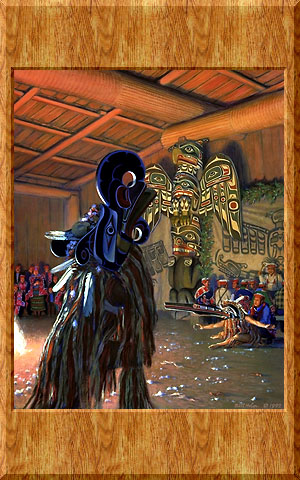
Original acrylic on canvas by Bill Holm © 1992
Collection of Tom and Jackie Barnard
The Cannibal Dancer, Hamatsa, has been lured back to his village from the house of his motivating spirit. There the assembled tribes have partially tamed him, but a phrase in his song has brought back his wildness, and he has dragged his encircling attendants around the floor and out behind the painted curtains at the back of the ceremonial house. A great beak is heard to snap, and one by one the masked dancers -- Hamsamala -- each accompanied by an attendant, step into the firelight. The Hamsamala represent the associates of the Man-Eating-Spirit. They dance upright at the corners of the floor, then drop to jump squatting and turning, finally to sit on the ground, their great beaks swinging and shuddering. A woman with taming power, shaking a round rattle, sings to calm the wildness of the dancers. The dancers rise shouting, snap their beaks, and move to the next corners. When the last Hamsamala has disappeared, the Hamatsa reappears and eventually his taming is completed.
The Hamatsa is the most prestigious of the Winter Ceremonial dances of the Kwakwaka'wakw people of the northern Vancouver Island area. The masks used in the taming of the Hamatsa are among the most flamboyant in all of Northwest Coast art. Those seen here are the work of the master artist Willie Seaweed. The carver is shown standing among the singers, enjoying his works in action. The setting is the Gwa'yasdam's village Raven House of Chief John Scow, the carved posts of which are now in the Seattle Art Museum.
A limited edition offset lithograph from the original painting is available from Stonington Gallery, 2030 First Avenue, Seattle, WA 98121; tel:(206) 443-1108, fax:(206) 443-6580; www.stoningtongallery.com.